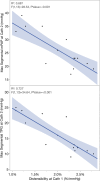Pharmacologic Management of Segmental Pulmonary Hypertension in Children After Unifocalization and Pulmonary Artery Reconstruction: Initial Experience
- PMID: 40741161
- PMCID: PMC12309978
- DOI: 10.1002/pul2.70134
Pharmacologic Management of Segmental Pulmonary Hypertension in Children After Unifocalization and Pulmonary Artery Reconstruction: Initial Experience
Abstract
Segmental pulmonary hypertension (PH) in congenital heart disease remains poorly understood with data limited to case studies. We performed a retrospective, single center study in children treated with PH medications after unifocalization/pulmonary artery reconstruction for major aortopulmonary collaterals (MAPCA). Drug response was determined by hemodynamic changes across at least two cardiac catheterizations. Mechanical properties of the segmental arteries were quantified by distensibility, stiffness, and augmentation indices. Twenty-five patients were included (8 surgical shunt, 17 complete repair), with 76% considered responsive to PH medications based on the relative decrease in maximum segmental mean pulmonary artery pressure (mPAP). At a median duration of 14 months (Q1-Q3 9.5-29), mPAP decreased from 33 mmHg (28-38) to 23 mmHg (21-32) (p < 0.001) with no significant change in blood flow distribution by lung perfusion scintigraphy. Subgroup analysis demonstrated a trend towards a larger percent decrease in mPAP of 35% (18-45) on dual therapy compared to 23% (Q1-Q3 3-36) on monotherapy (p = 0.16). In repaired patients, arterial distensibility at initial catheterization correlated with residual elevation in mPAP at follow-up (R 2 0.687, p < 0.001), with distensibility < 1.7%/mmHg associated with treatment failure. Among the lowest distensibility values were patients with JAG1 mutations, and among patients with extended follow-up, progressive increase in mPAP was identified only in those with hereditary PH-associated mutations. Children with segmental PH following pulmonary artery reconstruction can be successfully treated with PH medications. Although treatment efficacy may be limited in patients with high vascular stiffness and those with pathologic vascular mutations.
Keywords: MAPCA; Tetralogy of Fallot; congenital heart disease; genetics; vascular stiffness.
© 2025 The Author(s). Pulmonary Circulation published by John Wiley & Sons Ltd on behalf of Pulmonary Vascular Research Institute.
Conflict of interest statement
The authors declare no conflicts of Interest, although Doff B. McElhinney is a consultant and proctor for Medtronic.
Figures






Similar articles
-
Corrector therapies (with or without potentiators) for people with cystic fibrosis with class II CFTR gene variants (most commonly F508del).Cochrane Database Syst Rev. 2023 Nov 20;11(11):CD010966. doi: 10.1002/14651858.CD010966.pub4. Cochrane Database Syst Rev. 2023. PMID: 37983082 Free PMC article.
-
Macitentan and Tadalafil Combination Therapy in Patients with Pulmonary Arterial Hypertension and Cardiovascular Comorbidities: Real-World Evidence from OPUS and OrPHeUS.Adv Ther. 2025 Jul;42(7):3306-3333. doi: 10.1007/s12325-025-03180-0. Epub 2025 May 19. Adv Ther. 2025. PMID: 40388087 Free PMC article.
-
Doppler trans-thoracic echocardiography for detection of pulmonary hypertension in adults.Cochrane Database Syst Rev. 2022 May 9;5(5):CD012809. doi: 10.1002/14651858.CD012809.pub2. Cochrane Database Syst Rev. 2022. PMID: 35532166 Free PMC article.
-
Hemodynamic profiling of patients with a Fontan circulation using pulmonary pressure/flow relations during dobutamine stress and pulmonary vasodilation testing.Am J Physiol Heart Circ Physiol. 2025 Aug 1;329(2):H366-H373. doi: 10.1152/ajpheart.00105.2025. Epub 2025 Jun 12. Am J Physiol Heart Circ Physiol. 2025. PMID: 40506093
-
Cochrane in context: pharmacological interventions for hypertension in children.Evid Based Child Health. 2014 Sep;9(3):581-3. doi: 10.1002/ebch.1975. Evid Based Child Health. 2014. PMID: 25236306
References
-
- Bédard E., McCarthy K. P., Dimopoulos K., Giannakoulas G., Gatzoulis M. A., and Ho S. Y., “Structural Abnormalities of the Pulmonary Trunk in Tetralogy of Fallot and Potential Clinical Implications,” Journal of the American College of Cardiology 54 (2009): 1883–1890, 10.1016/j.jacc.2009.06.040. - DOI - PubMed
LinkOut - more resources
Full Text Sources

